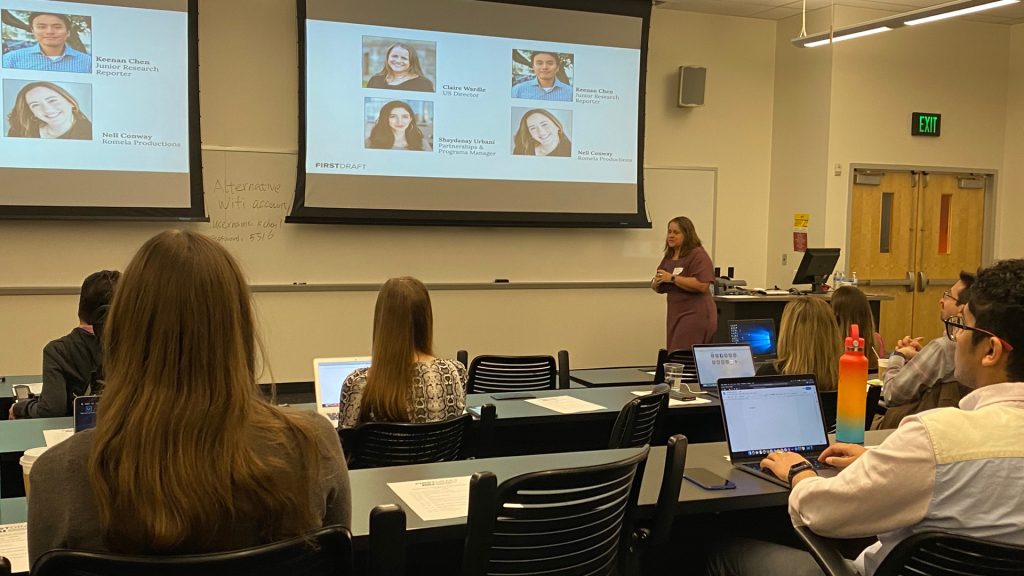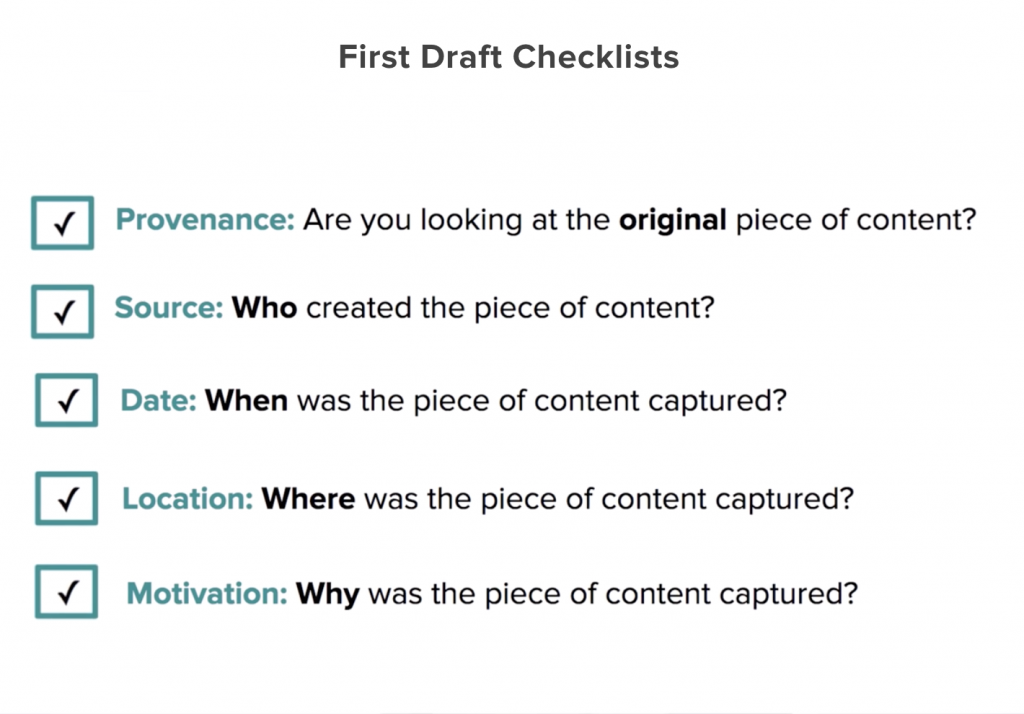
It was the final Friday in January, and the Valley of the Sun was delivering on its promise. But in one classroom on the campus of Arizona State University, the mood was far from sunny. Journalists representing most of the Phoenix print, TV and radio outlets had gathered in a classroom at the Walter Cronkite School of Journalism for a day of training from First Draft, which helps newsrooms combat misinformation. The journalists had formed teams and were deep into an Election Day simulation, trying to fend off disinformation campaigns. They were faced with tweets suggesting threats and possible violence at polling places in certain neighborhoods; a photo posted to social media that looked as though the National Guard had been called out; a Reddit thread reassuring folks concerned for their safety that they need not vote in person and could instead simply cast their vote via text. In teams, the journalists were debating: How do we verify? What do we report? What wording do we use?
One thing became clear: “We are SO not ready for this,” as one participant put it.
Claire Wardle agrees. “I don’t think newsrooms think that it impacts them,” says Wardle, U.S. Director of First Draft and leader of the Arizona media training session. “There’s an understanding of disinformation certainly, but I think there’s that sense of well, that’s Russian trolls creating memes and sharing them on Facebook. I don’t think there’s an understanding that newsrooms themselves are being targeted.”
The threat is not only a barrage of misinformation — false reports, images, and videos — directly aimed at journalists. Even more alarming, today’s organized misinformation campaigns use journalism’s own strengths, like fact-checking and community reputation, and turn them against the news media.
Asked to give an average grade for local newsroom readiness, Wardle replies: “D.”
That’s where First Draft hopes to help. It’s a global non-profit that supports journalists, academics and technologists working to address challenges relating to trust and truth in the digital age.
To prepare for today’s misinformation campaigns, newsrooms need to first understand four important ways in which the traditions of journalism are being weaponized against the media.
“Fact-Checking Exposes False Reports and Rumors”
The practice of fact-checking and of debunking falsehoods seems foundational to what reporters do. But “the whole way that journalism works – which is the paradigm of ‘more sunlight is a disinfectant’ —
has been weaponized against the news media in the hopes that there will be more oxygen given to rumors,” says Wardle, who observes that newsrooms haven’t adapted their practices to account for the problem that “simply reporting on a (falsehood) to debunk it can make people take something more seriously.”
For example, a rumor may be debunked within the body of a web or broadcast story, but how is the story headlined, or teased on broadcast? Even debunked rumors get amplified this way.
“Media manipulation is now a key tactic of people who are trying to sow division in this country,” notes Wardle. “And so that means that they are trying to get newsrooms to give oxygen to rumors.”
“If Someone Big Says It, It’s News”
By definition, what ‘Newsmakers’ say is ‘news.’ At least, that’s another standard practice in journalism. Again, says Wardle, these institutional habits need to be reconsidered in light of coordinated misinformation campaigns.
“What do you do when a politician is repeating a conspiracy theory, which is more complex, and (reporting on) it requires giving more oxygen to the rumor?”
“That (practice) in many ways has been used against the news media, which is if somebody with a loud enough voice said it, then you’ve got no choice but to cover that.”
“Journalists are the Gatekeepers”
Another foundational principle of the profession is that journalists are the gatekeepers for their communities. “It used to be that the audience was reliant on the gatekeepers,” says Wardle. “But the audience itself is now networked.”
The consequence is that stories, false as well as true, can be spread and amplified more quickly and before journalists can apply their traditional gatekeeper filtering role. Newsrooms can find themselves perpetually playing ‘catch-up’ to social, viral reports in a world where socially connected audiences rely more on those in their own ‘network’ than on traditional media sources.
“Local News is the Most Trusted”
Journalists working in local media are justly proud of the consistent findings by Pew Research and others that local news outlets are the most trusted news sources. But rather than insulate local newsrooms from the effects of media mistrust, that makes them a target.
“It’s a very effective mechanism to create sites that look like professional news sites,” says Wardle.
Columbia Journalism Review published a report in December documenting the rise of false, ‘look-a-like’ sites intended to appear to be reputable local online news sources that were in fact fronts for pushing politically slanted content.
Wardle also notes that an NYU review of Facebook posts by the Internet Research Agency found that Russian trolls shared five times more links to actual local news sites than to faked sites. “They would take existing, real local news headlines and amplify them to sow division.” One of the goals of misinformation campaigns, notes Wardle, is to undermine trust in media. So being alert to the ways your content is being shared – and your news brand is being depicted — now has to be part of a newsroom’s work.
Worried yet? Wardle hopes so. The first step in responding effectively to efforts at information manipulation is facing up to those threats. So what can a newsroom do? Wardle urges newsrooms to report in ways that “inoculate people to not only what these threats might be, but why people might be pushing them.”
Here are six practical recommendations from First Draft — actions newsrooms can take to better prepare themselves and their communities to detect and defeat misinformation.
1. Practice Worst-Case Scenarios
Newsrooms do election planning meetings anyway. Wardle suggests newsrooms host brown-bag sessions right away and invite staff to brainstorm the worst that could happen. “Pretend that you’re a troll,” says Wardle. “With a whiteboard, come up with all the ways that you might discredit or undermine the Census, or the election.”
Wardle says newsrooms are usually quite good at imagining the wide range of possible manipulations, from faked images and videos, to coordinated false reports of voting issues or threats and other voter suppression and intimidation tactics. But she also points to subtler tactics, like someone posing a question at a press conference based on an unsubstantiated rumor, to ‘force’ the mainstream media to report on and therefore amplify the rumor. The purpose of this exercise is to help the entire newsroom realize the magnitude of the threats.
2. Choose a Champion
Content verification and combating misinformation requires a team effort, and everyone in the newsroom should get trained in the basics of content verification. First Draft recommends sharing a checklist like this that all newsroom employees can use.

But Wardle says it’s crucial to have a designated owner at the manager level who can be both a category expert and a go-to resource for others in the newsroom. This subject-matter expert would ideally get deeper training now in order to be ready to be a resource to the news teams as they continue to cover stories like the Census and election run-up.
3. Audit Your Security and Tools
Consider how reliant the typical newsroom is on its internal communication systems. Whether it’s Slack or direct messages, closed Facebook groups or even email, now is the time to assess: How secure are those systems from being hacked?
On the verification side, how many newsroom employees have pre-installed or bookmarked the minimum ‘toolkit’ of verification sites and software? From reverse image search to the “Wayback Machine” (to save web pages that may be changed later) to bot-checkers, there are a core set of verification capabilities that all newsroom employees should have and know how to use. Better to install them now than in the midst of a breaking news event. For ideas on what belongs in your toolkit check out First Draft’s recommended 10 Verification Tools for Newsrooms on a Budget.
4. Update Ethics Practices to Deny Oxygen to Rumors
Journalists are well trained in ethical treatment of subjects, handling sensitive information and sourcing. “I think we haven’t necessarily had the same ethical conversations about covering some of these fringe and conspiracy spaces,” observes Wardle, “and what it means to add legitimacy to those rumors.”
It’s worth reviewing newsroom practices for both on-air and online when it comes to fact-checking and reporting on false narratives. Wardle suggests that even the traditionally lauded “fact-check” story can do surprising harm if the headline or tease merely repeats the rumor, counting on the audience to go ‘beyond the headline’ to find out the answer to whether the fact-check was true or false. “Yes, you might be debunking,” warns Wardle, “but actually if we repeat the rumor within the headline we are causing more harm.”
Another example: Repeating misleading phrases within story headlines can boost their profile as “key words” on search, which Wardle says is one of the new tactics of those intentionally trying to sow division. A third example is repeating (amplifying) statements by “Newsmakers” when those statements have already been demonstrated to be false.
5. Inoculate Against Misinformation Methods
Inoculation isn’t just good for your physical health. “In the context of information disorder, if you get people to think about the tactics and techniques that they might expect to see, when they see it, they are more likely to say, hang on, there’s something about this that resonates. I remember this,” says Wardle.
Newsrooms can build reporting around helping audiences understand what are the methods used by disinformation actors, what their motives might be, and how they might benefit. Wardle notes that research how this exposure to the tactics and methods in advance can help ‘inoculate’ both journalists and everyday news consumers to recognize manipulation efforts more easily.
6. Build an Election Misinformation Plan (that includes collaboration with other newsrooms)
In addition to the usual election planning, newsrooms need to have procedures (including a staffing plan) in place for the kinds of worst-case scenarios described here. One other key, says Wardle: Collaboration with other newsrooms. Newsrooms can gain strength in numbers, coordinate on verification and support each other in case of active efforts targeting news outlets.
Newsrooms are very good at doing the ‘debrief’ of what went wrong after a big breaking news story. Wardle says that’s not good enough when it comes to what’s at stake this year in terms of the potential for information disorder: “One of the threats in 2020 is to undermine the institution of the media itself.”
FOR MORE INFORMATION:
Non-profit First Draft offers a range of free online training tools, can arrange newsroom trainings by appointment, and has Live Simulation training sessions (with space available at press time) in several cities including Austin (Feb 22), Miami (Feb 24), Ohio (March 2) Athens GA (March 4), Tallahassee (March 6), with future trainings TBD in Harrisburg PA and Baltimore. Event details: https://firstdraftnews.org/project/live-simulations/